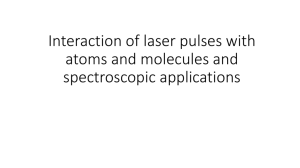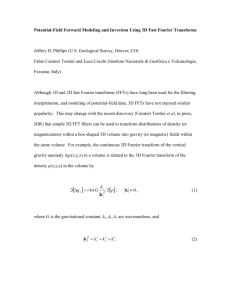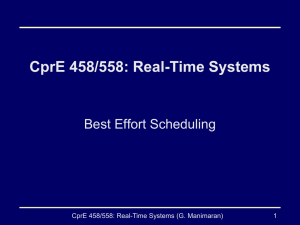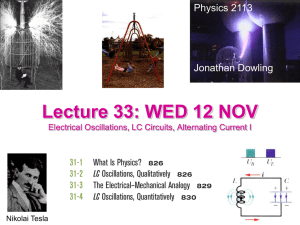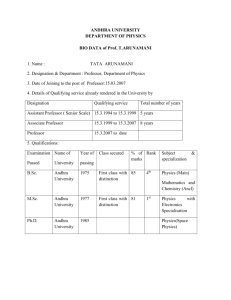CH10: Ionosphere I:: Profiles
advertisement
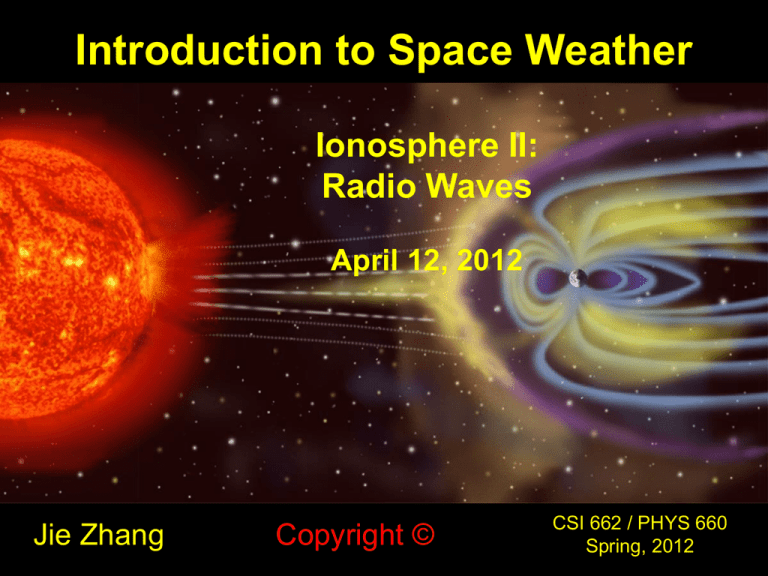
Introduction to Space Weather
Ionosphere II:
Radio Waves
April 12, 2012
Jie Zhang
Copyright ©
CSI 662 / PHYS 660
Spring, 2012
Roadmap
•Part 1: Sun
•Part 2: Heliosphere
•Part 3: Magnetosphere
•Part 4: Ionosphere
•Part 5: Space Weather
Effects
CH10: Ionosphere I
CH11: Ionosphere II
CSI 662 / PHYS 660
CH10: Ionosphere I
10.1 Atmospheric Layers
10.2 Density Profiles of Ionosphere
10.3. Ionization Production and Loss
Plasma-14: Chapman Layers
Apr. 12, 2012
CH10: Ionosphere I
References and Reading Assignment:
•KAL CH 8.3.1 (on Atmospheric Layers)
•KAL CH 8.3.2
(on Chapman Layers)
•PRO CH4.1 (On Atmospheric Layers)
•PRO CH4.2 (On Ionization Production and Loss)
•PRO CH4.3, CH4.4 and CH4.6 (on the Density profile)
Introduction
• Fluctuation of geomagnetic field by atmospheric current
(Kelvin, 1860)
• First transmitting radio waves across Atlantic Ocean (Marconi,
1901)
• Solar UV radiation responsible for the charge carriers
(Kennelly, Heaviside and Lodge 1902)
• Radio wave experiment on ionosphere (Appleton 1924)
• Appleton was awarded the Nobel prize for the work of
ionospheric physics.
CH 10.1 Atmospheric Layers
Horizontal Structure of the Terrestrial Atmosphere
Atmospheric Layers
Classified by temperatures
• Troposphere
• 0 10 km
• ~300 K 200 K
• Stratosphere
• 10 50 km
• ~200 K 250 K
• Mesosphere
• 50 km 80 km
• ~250 K 160 K
• Thermosphere
• > 80 km (~10000)
• 160 K ~1000 K
Atmos. Layers
Classified by Gravitational binding
• Barosphere
• 0 km 600 km
• binding
• Exosphere
• > 600 km
• Escaping or evaporation
Classified by Composition
• Homosphere
• 0 km 100 km
• Homogeneous
• Heterosphere
• 100 km ~2000 km
• Inhomogeneous
• Hydrogensphere (Geocorona)
• > ~2000 km
• Dominated by hydrogen
Basic Parameters
Chemical composition (ni/n):
• Height = 0 km, 78% N2, 21% O2, 1% others (trace gases)
• Height = 300 km, 78% O, 21% N2, 1% O2 (O2 is much easier to
dissociate than N2)
Pressure:
• Height = 0 km, P = 105 pa
• Height = 300 km, P=10-5 pa
Atomic Number
Mass Number
H
He
N O
1
1
2
4
7
14
f (Degree of freedom) 3
3
3
3 translation
8
16
N2
O2
28
32
3
5
5
+ 2 rotation
Barospheric Density Profile
Hydrostatic equilibrium or aerostatic equations
dP
g
dz
P
mn m
kT
dP
P
dz
H
kT ( z )
H ( z)
The Scale Height
m ( z) g ( z)
h
P (h) p (h0 ) exp{ Hdz( z ) } Barometric Law
h0
h
n(h) n(h0 ) TT((hh0)) exp{ Hdz( z ) }
h0
n(h) n(h0 ) exp(
isothermal
h h0
H
)
Continued on April 19,
2012
Barospheric Density Distribution
• Isothermal Scale
Heights
– H = kT/(mg)
for g(200 km)
HO2 = 0.028* T
HN2 = 0.032* T
HO = 0.0567* T
• Atomic O relative
abundance
increases quickly
with height
N2
O
O2
<~100 km, homosphere: same
abundance
>~100 km, hetereosphere:
abundance changes with height
SOLAR - TERRESTRIAL
ENERGY SOURCES
Source
Energy
(Wm-2)
Solar Cycle
Change (Wm-2)
Deposition
Altitude
Solar Radiation
• total
• UV 200-300 nm
• FUV 0-200 nm
1366
15.4
0.15
1.2
0.17
0.15
Particles
• electron aurora III
• solar protons
• galactic cosmic rays
0.06
0.002
0.0000007
Peak Joule Heating (strong storm)
• E=180 mVm-1
Solar Wind
0.4
0.0006
surface
10-80 km
50-500 km
90-120 km
30-90 km
0-90 km
90-200 km
above 500 km
SPECTRUM
VARIABILITY
TOTAL
IRRADIANCE
VARIABILITY
Solar Energy
Deposition
Atmospheric
Structure
SPACE
WEATHER
EUV
FUV
MUV
RADIATION
GLOBAL
CHANGE
Energy Absorption Processes
• Three basic processes
1. Ionization
1. O2 + h O2+ + e*, …
2. Dissociation
1. N2 + h N + N, …
3. Excitation
1. O + h O*
– The basic processes can be combined, e.g.,
ionization excitation
• Each basic process has a corresponding
reverse process
1. Ionization <-> Recombination
2. Dissociation <-> Association
3. Excitation <-> Radiation
CH10.2. Density Profiles of
Ionosphere
CH10.2 Electron Density Profile
Height of maximum
density:
200 – 400 km
Maximum Ionization
Density:
1 – 30 x 1011 m-3
F2
F1
Column Density:
1 – 10 x 1017 m-3
E
Total ne
Density Profiles
Ionosphere:
• Weak ionization
• Electrons and ions
represent trace
gases
• Ion/neutral ratio
(n/nn)
• 10-8 at 100 km
• 10-3 at 300 km
• 10-2 at 1000 km
Ionosphere
Layers
Classified by Composition of charge
carriers:
• D region
• h < 90 km
• Only day time
• Charge H3O+: cluster ions
• E region
• 90 km < h < 170 km
• Peak at ~120 km
• Charge O2+ :ionization of O2
• F region
• 170 km < h < 1000 km
• Peak at ~ 250 km
• Charge O+ : ionization of O
• Fragment into F1 (mixture of
O2+ , O+ ,NO+) and F2 (O+)
during the day time
Plasma 14- Chapman Layer
• The Chapman profile of an ionospheric layer results from the
superposition of the height dependence of the particle density
and the flux of the ionizing electromagnetic radiation
q ( z ) n i I ( z )
q : ionizat ionrat e
n : neut ralpart icledensit y
i : ionizat ioncross sect ion
I : radiat ionint ensit y
Chapman Profile
Chapman Layer
• Neutral particle density: barometric height formula
z
n( z ) n0 exp{ }
H
• Radiation Intensity: Bougert-Lambert-Beer’s Law
dI
I a n
dz
I ( z ) I exp{ a n( z )dz} I exp{ }
z
T heopticaldepth
a n( z )dz
z
Chapman Layer
z
}
H
At thesurface of theEarth,z 0, but , I 0
q( z ) i n0 I exp{
thus q(z) 0
At thefar topof theionosphere, z , n 0
thus q(z) 0
T hus, themaximumis in between
One particularionizationelementproducesone particleChapmanlayer :
e.g., O for F region,O 2 for E region
CH10.3. Ionization Production
and Loss
The density of charged particles is determined
through the dynamic balance of the
continuous ionization production rate and
the loss rate
Ionization Production
• Photoionization
• Charge Exchange
• Particle Precipitation
Photoionization
Processes
– O + h ( 91.0 nm) O+ + e
– O2 + h ( 102.8 nm) O2+ + e
– N2 + h ( 79.6 nm) N2+ + e
Photon Energy Threshold
Species Dissociation Dissociation
(nm)
(eV)
O
O2
N2
242.37
127.04
5.11
9.76
Ionization
(nm)
Ionization
(eV)
91.044
102.78
79.6
13.62
12.06
15.57
Charge Exchange
CE
X Y X Y
qX k x,Y nX nY
CE
CE
Charge Exchange Process
Charge Exchange Rate (q)
Charge Exchange constant
(k, from lab experiment)
• Does not change the total ionization density
• Important source for NO+ and O2+ in the lower
ionosphere
• Important source for H+ for the plasmasphere
Particle Precipitation
X e primary ( E 12ev) X esec onday e primary
• Play an important role in high latitude
Ionization Loss
• Dissociative Recombination
• Radiative Recombination
• Dissociative recommendation is more
efficient than radiative recombination
• Charge Exchange
Ionization Loss
• Dissociative Recombination of Molecular Ions
DR
XY e X Y
l XY
DR
k x,Y nX Y ne
DR
k x,Y 1013 m3s 1
DR
Ion loss Rate
Dissociation Recombination
k: Reaction constants
Largest reaction constant for
O2+,N2+, and NO+
Ionization Loss
• Radiative Recombination of Atomic Ions
RR
X e X photon
kO
RR
18
3 1
10 m s
Ionization Loss
• Charge Exchange
kO , N
k O ,O
CE
5 10
19
3 1
ms
2
CE
125 10
19
3 1
ms
2
• Charge exchange is efficient due to the
presence of large amount of neutrals
Ionization Loss
• E region (O2+)
• Dissociative recombination is the quickest way of
removing ions and elections
l E region
DR
kO
DR
2
nO ne
2
nO ne n
2
l E region (h) n (h)
2
Ionization Loss
• F region (O+)
• Charge exchange is the quickest way of removing O+ ions
lF region
DR
k O ,O
2
CE
nO nO
2
nO ne n
lF region (h) (h)n(h)
where... (h) kO ,O
2
CE
nO2 (h)
Density Balance Equation
ns
t
qs ls ds
• Density is determined by the ion production term, ion
loss term and ion diffusion term, for species s
d s (nsus )
• Day time: approximated by production-loss equilibrium
qs ls
• Night time: production is negligible. A good
approximation:
ns
t
ls
Variation of Ion Density
• The ionization production depends on the solar
radiation intensity and the zenith angle
• The ion density shows daily, seasonal variation as well
solar rotation and solar cycle effects
After sunrise
n
t
3 1
10 m s
8
TEC (Total Electron
Content, 1 TEC=1016
electrons/m2) diurnal
variation
Variation of Ion Density
D and F1layers may
disappear at
night
The End
